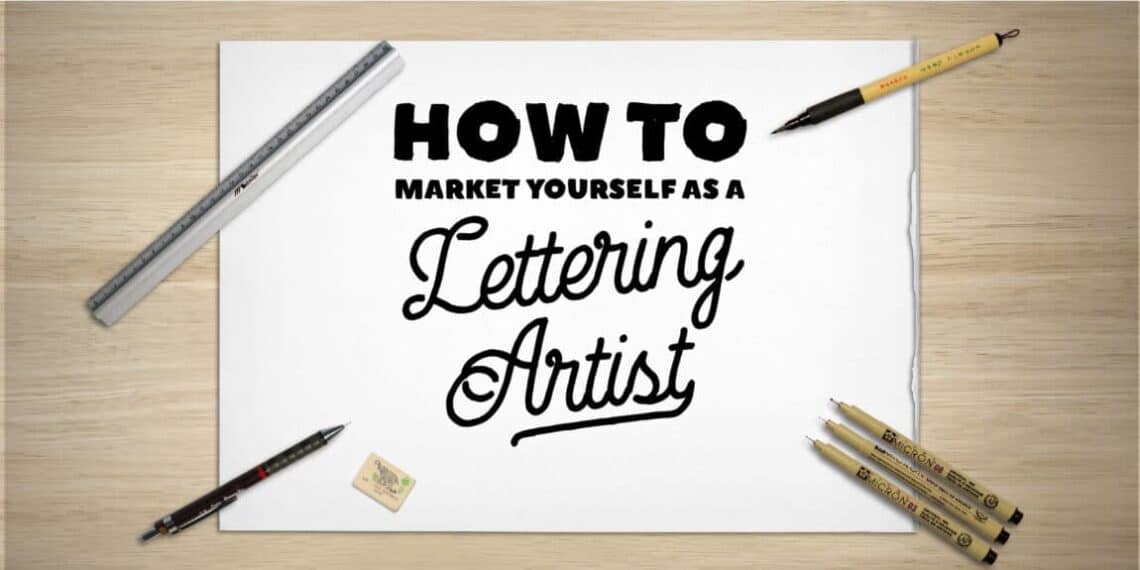This post and the photos within it may contain affiliate links. If you purchase something through the link, I may receive a commission at no extra charge to you.
Are you struggling with marketing?
You want to grow an audience and achieve something more with your creative skills, but you are not sure how and where to start?
Marketing is often a daunting thing for many creatives.
Over the past decade, we’ve watched the hand lettering space explode in terms of popularity.
So it’s no wonder that many are asking themselves, ‘is it too busy for anyone to notice me?’ or ‘is it too late to get started?’.
I’m here to tell you that there is still a ton of opportunity to breakthrough.
In fact, perhaps there’s more opportunity than ever, you just need to arm yourself with the right marketing tools.
That’s exactly what I want to bring you in this article.
I work with thousands of creatives each month to help them get a better handle on their marketing.
That been said, in this post, I will be talking about the following things –
- Common ‘’ marketing strategy’’ beginner mistakes
- Niching – what is it, and how to find your own niche
- Differentiation – stand out from the noise in a unique way
- Your message is more important than your talent
- Distribution – developing a consistent strategy
- Building an actual business – likes won’t pay the bills!
I will provide some actionable steps for each section, so this way, you can immediately put the knowledge into practice!
Without any further ado, let’s get started!
1. Common ‘’ marketing strategy’’ beginner mistakes
The typical ‘marketing strategy’ many employs looks something like this:
- Post a random assortment of work.
- Attract an audience of fellow creatives/peers, rather than intended customers.
- Do this for a long time, slowly building a following.
- Try to achieve a huge following (but often fall short of this, and feel crappy about yourself).
- Hope clients come to you (they typically don’t).
Sound familiar?
I get it, marketing can be scary.
Plus, there’s a ton of misinformation floating around that can make it impossible to know where to allocate your time best.
Yes, the lettering space is more saturated than ever, but that also demonstrates a considerable demand in this style of work.
More letterers than ever are carving out a full or part-time living doing what they love.
Having worked with many of them, I can identify some core marketing principles that really work.
Actions step –
Identify if you have fallen into this pit of uncertainty, poor results, and generally slow growth.
Take a step back and look at the way you approach your marketing.
If you have answered yes to even one of the questions above, I recommend you read this whole article and start implementing change today!
2. Niching – What is it, and how to find your own niche.
No, it’s not a dirty word, and nor will it creatively limit you, if done right.
Niching can be your best friend.
In a world where 99% of lettering artists are posting a random assortment of work, with little to no consistency, niching can help to focus you like a laser.
Let’s look at a couple of the key ways you can niche:
1. Industry/Topic
Focusing your hand lettering around a core topic can help attract a community of folk who share that interest with you.
These topics can be broad or narrow.
I see fantastic lettering around topics such as:
- Bible quotes
- Puns
- Rude jokes
- Being a mom
- Being a millennial
- Current affairs
- Motivation
- Philosophy
The possibilities really are endless.
2. Style of Lettering
This can be an equally effective way to a niche.
When I think of unique lettering artists, I think of James Lewis with his fantastic hand-painted 3D signage inspired lettering.
I think of Becca Clason with her superbly creative food lettering, often done to animation.
Some broader stylistic niches include analog vs. digital (typically iPad).
Or brush script vs. gothic. Watercolor vs. ink.
So what makes a great niche?
Ideally, you want an under-served niche, but has a high level of demand.
For example – brush lettering of motivational quotes.
It seems like a BILLION accounts are posting that stuff.
So it stands to reason that it’ll be pretty difficult to stand out in that over-saturated niche.
However, for something like ‘digital lettering of bible verses,’ there’s quite a massive market of religious folk who enjoy beautiful lettering, yet significantly fewer people serving them (compared to the motivational stuff).
Check out the video below where i explain how you can combine your interests with your designs.
Think of niching this way:
There’s a room of 1000 people.
800 of those people are into pop music.
200 are into country music.
1000 musicians suddenly enter the room.
990 of them are pop musicians.
10 are country musicians.
For every country musician, 20 people would like to hear their music.
For every pop musician, there’s less than 1.
Action step –
Grab a piece of paper and a pen and write down at least 5 different niches you are interested in – for both topic/industry and style of lettering.
Once you have them written down, it will be easier for you to pick the ones you want to stick with.
There isn’t a rule on how many niches you should choose.
You can do one or five of them.
However, you have to understand that picking only one could be a bit limiting while picking five could be too broad.
Perhaps the best would be sticking to 2-3 niches, but I’ll leave this decision up to you!
Check out the post below for some extra tips on finding the right niche for you.
3. Differentiation – How to stand out from the noise
Niching is one way of differentiating you from the crowd.
Differentiation is huge.
If you do what everyone else is doing with your hand lettering, you become virtually invisible.
Yet this is what so many lettering artists end up doing.
They see the Stefan Kunz’s, Jessica Hisches, Ian Barnards, and Lauren Hom’s and assume that to gain notoriety and success, they should do the types of lettering that those people are doing.
The trouble is, hoards of others have the same idea, so before you know it, you’re lost in a sea of lookalikes.
With the wave of popularity around hand lettering, standing out and being different has never been so important.
When it comes to this point, your imagination and creativity is the only limit.
I challenge you to look at what everyone else is doing and ask yourself, ‘how can I flip this and go another way?’.
I was recently asked by a hand-letterer on Twitter, ‘how do I stand out?’.
I told her endless ways!
Create giant lettering from objects and fly a drone upwards into the sky to reveal your choice of wording!
I guarantee not many people are doing that.
Of course, you don’t need to go that extreme, but realize that sitting on an iPad and churning out some generic phrases/affirmations is going to hurt you rather than help you when it comes to getting your work noticed!
Here are some quick ideas:
- Lettering from objects relevant to the phrase/word
- Animate your lettering in interesting/unique ways
- Show a unique story that explains the inspiration behind each piece (show this using image or video within your content)
- Think of a ‘schtick’ (a unique angle to your lettering). Lauren Hom had ‘lettering for lunch’ where she got free lunches from restaurants for doing their boards. This got a ton of PR! What’s an interest of yours that you could combine with lettering for a unique spin on things?
- If you’re doing analog lettering, think of unique ways to destroy or ‘send-off’ your lettering after completing it (imagine a Viking funeral).
- Lettering a diary through a tough or valuable point in your life (sharing vulnerability, triumph, struggle, etc…)
- Draw on unusual surfaces (ice, sand, mud, etc…)
- Lettering open letters to influential people around topics you feel passionately about
Action step –
Grab a piece of paper and start laying down ideas for your content.
Writing things down and planning will, without a doubt, help you maintain clarity in the process.
Like I just mentioned, it’s essential to find something that differentiates you from the crowds.
However, what is even more important is that it has to be something you enjoy doing and creating!
If you are just focused on what others might like so you could grow an audience, your motivation will quickly plummet, and the whole strategy loses its purpose.
The key is finding something that is different and innovative while at the same time that you enjoy creating consistently.
4. Your message matters more than your talent
One of the most common mistakes I see lettering artists making is that they will endlessly focus on improving their talents, but they neglect their message.
Don’t get me wrong; if your lettering stinks technically, you’ll likely struggle to find traction.
However, there are an awful lot of talented letterers out there, most of whom are struggling to stand out.
Whether you’re an illustrator, a hand-letterer, or really any type of creative, you HAVE TO HAVE SOMETHING TO SAY if you want people to pay attention.
Even if you’re technically super proficient, if your messaging is bland as hell, it won’t catch on much.
I see this all the time; there are lettering artists with bags of talent just not being seen, because their message is boring.
On the flip side, I see decent lettering artists, but nothing special, who are doing exceptionally well because they’ve nailed their niche and messaging.
Once you are consistently putting out beautiful lettering around a theme/message that deeply resonates with your intended audience in a super exciting way.
At this point, you’ll start to find traction.
Which one of these messages grabs you more?
‘Enjoy today.’
or
‘You don’t need anyone’s permission to be sexy as hell!’
(That second quote is from my friend Dina Rodriguez at Letter Shoppe, where incidentally she attracts a fiercely loyal tribe of supporters who adore her work. This is predicated on her compelling messaging and niche, her talent is secondary to this, which is something she openly admits).
I don’t know about you, but I’ve become totally blind to hand-lettering quotes with generic life affirmations.
‘Seize the day,’ ‘dream big,’ ‘live, laugh, love.’
That stuff has become so played out, yet letterers continue to crank it out daily.
If you’re recycling over-used quotes for your material, you’re going to struggle.
Bring your originality, creativity, and uniqueness to the table and give yourself a chance of breaking through!
Action step –
In order to stand out in your niche, you need to define your audience.
The best way to define your audience is by creating an audience persona.
Below you can see the example we used to define the audience persona for Design Cuts.
Use the example below to create your own audience persona and stand out in your niche.
5. Distribution – developing a consistent strategy
Now that you’ve hopefully pinned down your niche, got a fantastic intended audience, and you’re putting out work that is more unique and less generic, you need to think about distribution.
Marketing is not a case of ‘build it, and they will come.’
This isn’t a field of dreams.
You need to work out how to get your work in front of OTHER audiences, preferably larger audiences.
This is absolutely key to growing your fan-base.
Here are some actionable ways to increase your distribution:
- Collaborations (cross-pollinate audiences with another creative by collaborating on a piece together. When you both promote it, audience members from both sides will discover the other lettering artist).
- Challenges (Homwork, 30 Days of Bible Lettering – these types of challenges are fantastic as you can gain exposure via the associated hashtag to get more eyeballs on your work. If it’s a good fit for your chosen niche, find the right challenge for you, and get involved!).
- Get involved in your community on social media (I’m a huge believer in the one-to-one work that goes with building a real community. Go outside of your comfort zone, escape the bubble of your own little community, and get yourself out there. Connect with other lettering artists. Comment on their work. Connect with ideal/intended customers of your work. Be vocal, be sociable, be seen everywhere. Over time the sheer visibility of these actions will get people coming back to your profile. If your work is unique, quality, focused, and of interest to them, they will follow you).
- Produce shareable work (Honestly, the best way to get your work shared by others isn’t asking them, submitting to collectives, or anything like that. It’s producing work that’s so good people want to share it. Remember, much of this comes down to the quality of the message and focusing on an intended audience. If your message and work hit emotionally deep, people will have much more of a reason to share it. They want to make their own followers/friends laugh, cry, feel something. That emotional resonance is where shareability comes from.)
Action tip –
Plan out a schedule that fits within your existing routine.
If you can only separate 15-20 minutes per day, that’s totally fine, but then do it EVERY SINGLE DAY!
Consistency over intensity is the key here.
Posting every single day with only 15-20 minutes will be quite tricky, but if that’s the case, you will share it just 2-3 times a week.
Even with that tempo, I’ve seen people skyrocket their growth!
Simply because it was done consistently over an extended period – remember, consistency is always better than intensity.
6. Building an actual business – likes don’t pay the bills!
If you have aspirations of lettering full time or getting paid for your passion, then you need to realize that a following does not mean you have a business.
Think carefully about how you want to monetize your talents.
You can do this in several ways, but for hand letterers some great options include:
- Selling prints of your lettering
- Producing educational materials (courses, ebooks, worksheets for other lettering artists)
- Client work
- Selling physical products that include your lettering (apparel, merch, etc…)
Sales will come much easier if you’ve:
- done the due diligence of defining your niche/audience
- worked to create compelling, unique work that resonates deeply with that audience
- working on your distribution to establish a healthy-sized audience
However, realize that you don’t need a massive audience to earn money from your skillset.
Don’t wait to build up an audience and then try to monetize it.
It’s better to develop a business (monetization) strategy and then work along with it.
One of my community members, Emma, recently completed 30 days of Bible lettering.
She had a couple of her community express interest in prints, so she used this as validation to go and organize a set of prints for the 30 designs she had created.
After organizing a launch for these, she exceeded her goal of selling 10 copies and sold over 50, generating over $1700 in revenue in just 1 week!
All of this was achieved with an Instagram following of 5600 people and a newsletter of just 100 people.
Action step –
Make a list with all the potential ways you could monetize your creative skills – you already have a couple of ideas above.
Still, you can definitely find out additional methods.
I would recommend sticking with one method for starters and then slowly expand.
You will be much more efficient in managing a single front.
Once you’ve picked a way to monetize your skills, start researching it.
Find out how exactly it works and what are the best practices for it.
Try to be very deliberate about the way you do things rather than shooting in the dark on hope for the best.
Wrapping things up
I see people every day, making a healthy amount of extra money with an audience of just a few hundred people or more.
It’s never been more possible to build an engaged audience around your work and to earn money, giving them amazing designs they’re excited to own!
But now i want to hear it from you!
Where do you struggle the most?
What is holding you back?
Be sure to let me know by dropping a comment below.
You can also keep up with my content on YouTube and Instagram.
Until the next time!
PS (a note from Max) – If you’re into business-related topics, be sure to check out this interview with Martina Flor.
Pin me!


Stay updated with my tutorials and get instant access to the Lettering Crate –
A growing library of free lettering & calligraphy resources that includes –
About the author

My day job is CEO at DesignCuts.com, where I’m leading a team of 17 talented people. We’re pouring our hearts and souls into disrupting the digital design space in the most positive way possible. In my (limited) spare time, I focus on helping my fellow entrepreneurs. It’s my greatest passion. I’ve helped hundreds of entrepreneurs make real progress in their businesses. No upsell, no ebook, no premium course. Just me, committed to helping you, for free. What’s the catch? There isn’t one, just message me for a guaranteed response.


This is the most brilliant advice I’ve ever read. Thank you for the enlightenment!
You are welcome Jenni, Cheers! 🙂
Hey Tom! Fantastic fantastic stuff here! I can’t tell you how many pages of great notess that you have helped me with over the past several months. I am still working tirelessly to try to niche down. I will get it soon…but damn…it’s hard!!! love the actionable steps you spell out here…thanks again so much! Ellen
Loved writing this, it’s such an important topic for letterers everywhere. Thanks for inviting me to share Max, I hope this helps a ton of people :).
I am super stoked that we finally did this! I hope it will help creatives on their marketing journey and also to realize that marketing doesn’t indeed have to be scary!